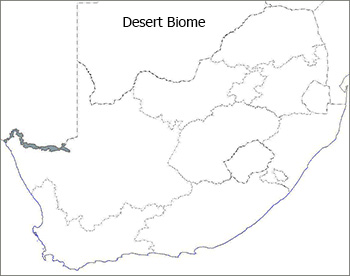This following text was written by Leslie Powrie

The Desert Biome is found under very harsh environmental conditions which are more extreme than those found in the Succulent Karoo Biome and Nama-Karoo Biome. The climate is characterized by summer rainfall, but high levels of summer aridity. Mean annual rainfall is from approximately 10mm in the west, to 70 or 80mm on the inland margin of the desert. In reality, the rainfall is highly variable from year to year. Most true desert in southern Africa is found in Namibia, although an outlier does occur in a small part of South Africa, mainly in the Springbokvlakte area of the Richtersveld in the lower Orange River valley.
The vegetation of the Desert Biome is characterized by dominance of annual plants (often annual grasses). This means that after a season with rarely abundant rains, the desert plains can be covered with a sea of short annual grass. Whereas in more normal years, the plains can appear bare with the annual plants persisting in the form of seed.
Perennial plants are usually encountered in specialized habitats associated with local concentrations of water. Common examples of these are broad drainage lines or washes. The well-known shrub, Welwitschia mirabilis, of the Namib Desert, occurs in such areas. The perennial grass, Stipagrostis sabulicola, occurs sporadically on large dunes which contain substantial stores of water. Nearer the coast in Namibia, the role of coastal fog also governs distribution of certain species commonly associated with the desert.
The Desert Biome includes an abundant insect fauna which includes many tenebrionid beetles, some of which can utilize fog water.
Click images below to enlarge.







